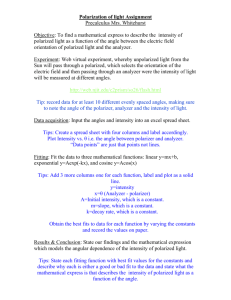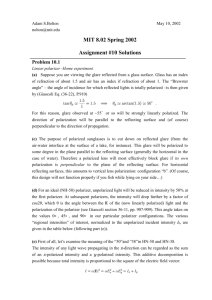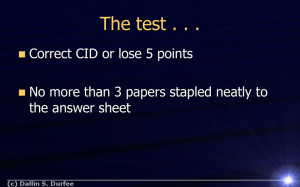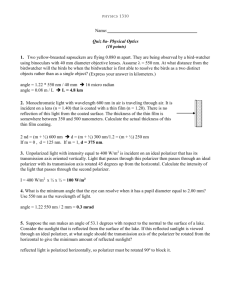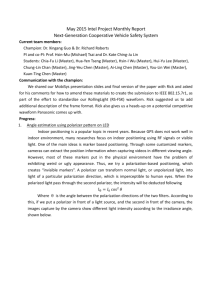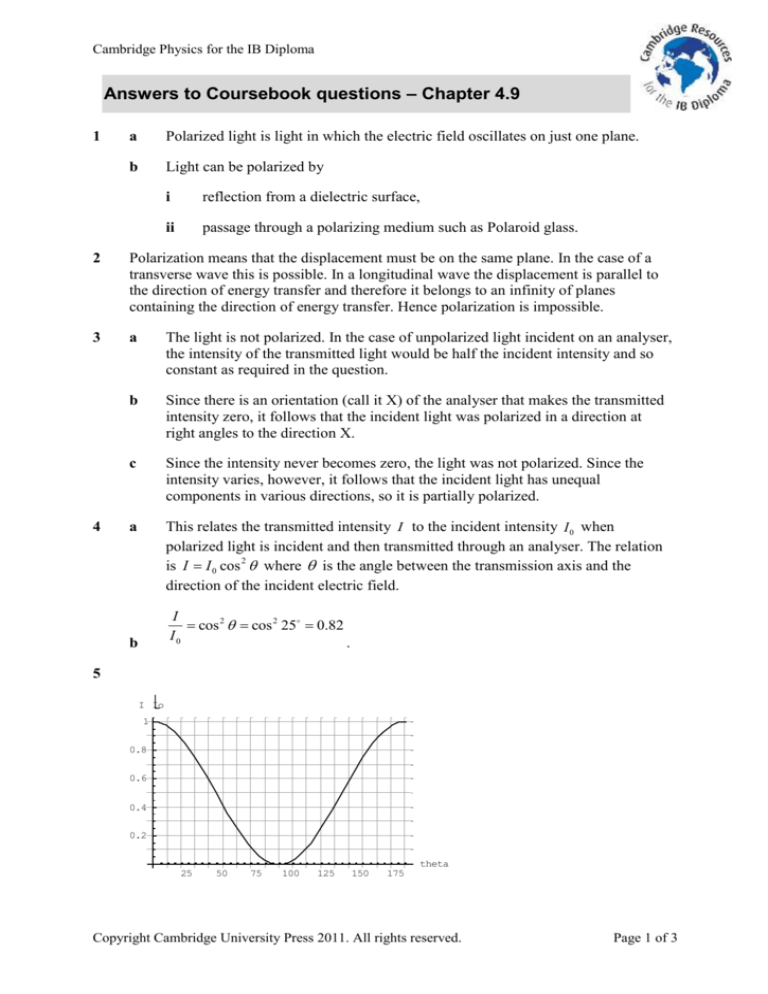
Cambridge Physics for the IB Diploma
Answers to Coursebook questions – Chapter 4.9
1
a
Polarized light is light in which the electric field oscillates on just one plane.
b
Light can be polarized by
i
reflection from a dielectric surface,
ii
passage through a polarizing medium such as Polaroid glass.
2
Polarization means that the displacement must be on the same plane. In the case of a
transverse wave this is possible. In a longitudinal wave the displacement is parallel to
the direction of energy transfer and therefore it belongs to an infinity of planes
containing the direction of energy transfer. Hence polarization is impossible.
3
a
The light is not polarized. In the case of unpolarized light incident on an analyser,
the intensity of the transmitted light would be half the incident intensity and so
constant as required in the question.
b
Since there is an orientation (call it X) of the analyser that makes the transmitted
intensity zero, it follows that the incident light was polarized in a direction at
right angles to the direction X.
c
Since the intensity never becomes zero, the light was not polarized. Since the
intensity varies, however, it follows that the incident light has unequal
components in various directions, so it is partially polarized.
a
This relates the transmitted intensity I to the incident intensity I 0 when
polarized light is incident and then transmitted through an analyser. The relation
is I I 0 cos 2 where is the angle between the transmission axis and the
direction of the incident electric field.
4
I
cos 2 cos 2 25 0.82
I0
.
b
5
I Io
1
0.8
0.6
0.4
0.2
25
50
75
100
125
150
175
theta
Copyright Cambridge University Press 2011. All rights reserved.
Page 1 of 3
Cambridge Physics for the IB Diploma
6
Following the argument (see page 274 in Physics for the IB Diploma) the
transmitted intensity will be half the incident intensity.
7
The intensity transmitted through the first polarizer will be half the incident intensity
I
i.e. I 0 .
2
After transmission through the second polarizer the intensity will be
I
I
I 0 cos 2 60 0 .
2
8
8
The first polarizer reduces the intensity by half and so the rest must reduce it by
1
.
50
Each polarizer will reduce the intensity by cos 2 10 0.9698 .
Hence with N of them the reduction will be 0.9698 N , i.e.
1
log 0.020
0.9698 N
N
128 so we need 128 additional polarizers.
50
log 0.9698
9
It does not have to be polarized. With unpolarized or polarized light, the transmitted
light is polarized in the direction of the axis of the polarizer. Since the second axis is at
right angles to the first, no light gets transmitted in either case.
10
We just need
11
I
12
a
The light transmitted through the first polarizer will be polarized in a given
direction. The second polarizer’s axis is at right angles to this direction, so the
electric field has zero component along the axis of the second polarizer. Hence no
light gets transmitted.
b
Light will be transmitted since now there will be a component of the electric field
along the second polarizer’s axis.
c
The situation is now identical to a and so no light goes through.
a
Light that has reflected off a dielectric surface with an angle of incidence equal to
the Brewster angle will be completely polarized parallel to the surface.
b
From tan n 54.5 .
c
The reflected and refracted ray will make a right angle in this case. Therefore the
angle of refraction is 90 54.5 35.6 .
a
tan n 53.1 .
13
14
1
cos 2 45 .
2
I0
cos 2 50 0.21I 0 .
2
b
n sin 1 cos tan
1
36.9
n
Copyright Cambridge University Press 2011. All rights reserved.
Page 2 of 3
Cambridge Physics for the IB Diploma
15
Light from the fish is insignificant compared to the glare of the light that is
reflected from the surface of the lake and so the fish is not seen. With Polaroid
glasses, most of the reflected light is blocked because it is horizontally polarized
and the glasses have a vertical transmission axis. Hence the light from the fish can now
make an impact in the observer’s eye.
16
This is the same as in Q15.
17
You should rotate the glass until the least amount of light goes through. The
transmission axis is then vertical with the glass in this position.
18
a
Optical activity is the ability of certain media to rotate the plane of polarization of
light propagating in the medium.
b
An optically active substance is a substance showing optical activity.
19
The concentration of the solution and the distance travelled by light in the solution.
20
You will need two polarizers, a sugar solution whose concentration will be varied and a
source of light. The solution will be placed in between the two polarizers whose axes
will be initially at right angles to each other. With the solution in between the
polarizers, light will be transmitted and so the second polarizer will have to rotated until
no light gets transmitted. The angle by which the polarizer is rotated is equal to the
angle by which the solution rotated the plane of polarization. The experiment is then
repeated for light travelling the same distance through the solution but with a different
concentration. This will give the dependence of the angle of rotation to the
concentration of the solution. In a different experiment, the concentration of the
solution will be kept constant but the distance travelled by light will be varied so as to
get the dependence of the angle of rotation to the distance travelled.
21
Apart from its use in Polaroid sunglasses, polarization is used in liquid crystal displays
and in stress analysis.
22
See page 277 in Physics for the IB Diploma.
Copyright Cambridge University Press 2011. All rights reserved.
Page 3 of 3




